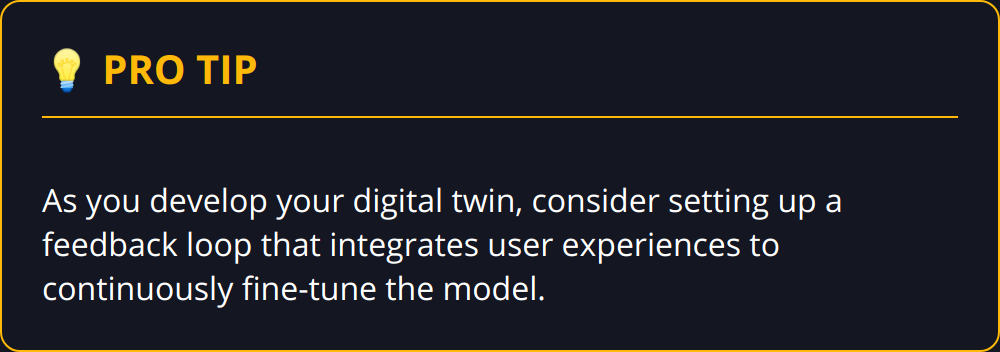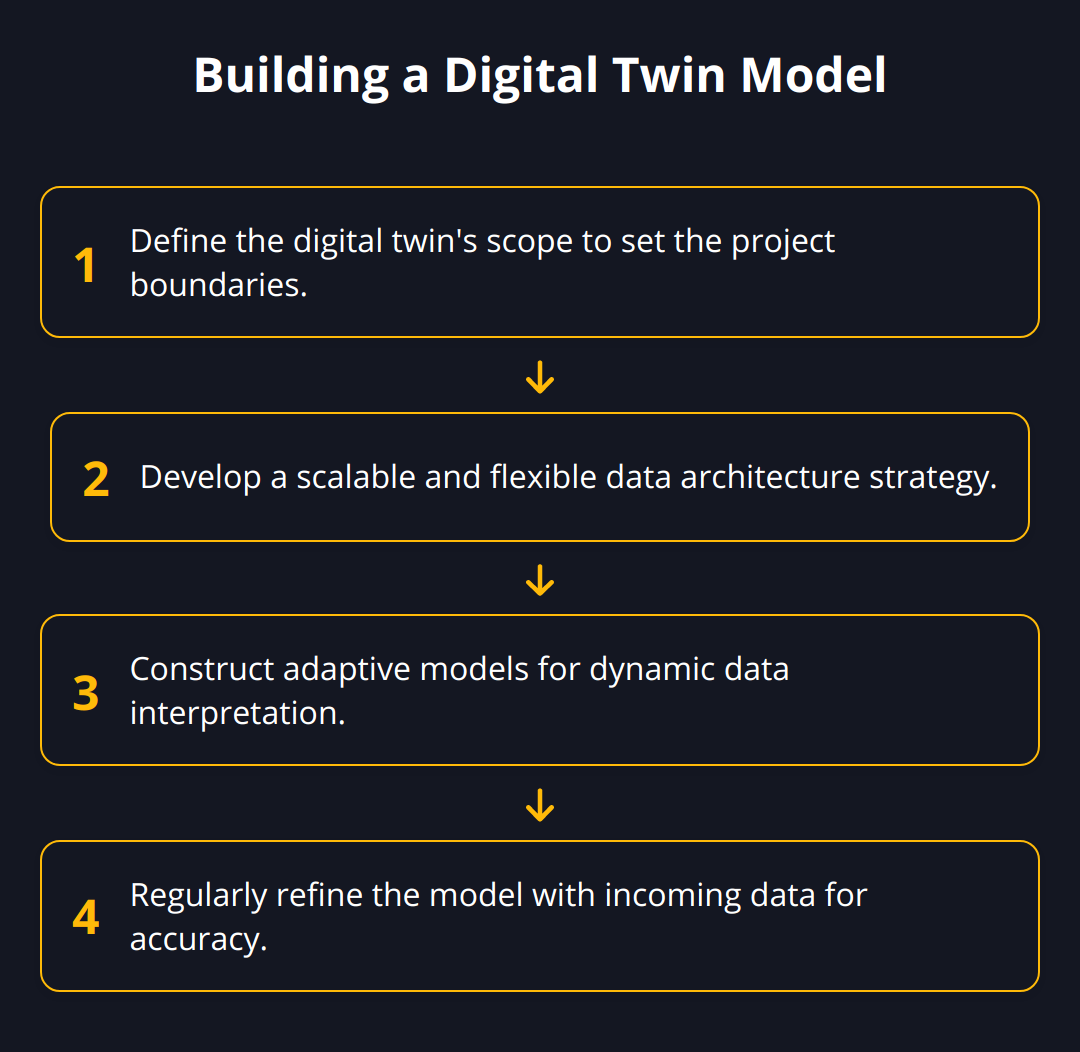Welcome to the dynamic world of digital twins and their analytics. At newroom connect, we understand the power of this technology to reshape industries and operations.
This blog post is designed to guide you through the initial steps and strategic tool selection, right through to implementation and ongoing optimization. Let’s share our professional insights to enhance your digital twin analytics journey.
Kickstart Your Digital Twin Analytics
When embracing digital twin technology, a solid grasp of its foundations is crucial. A digital twin is a sophisticated virtual model that mirrors a physical object, system, or process in real time. By harnessing real-world data, it unlocks insights which lead to improved decision-making and strategic outcomes across various sectors.
But before diving into analytics, setting clear objectives is paramount. Determine what you aim to achieve with your digital twin. Is it to streamline manufacturing, enhance product design, or predict maintenance needs? Objectives will shape your analytical approach, informing which data to capture and how to process it for the best results.
Here are action-oriented steps to initiate your journey with digital twin analytics:
- Map out the physical asset’s key characteristics you aim to replicate. This includes structure, functionality, and behavior.
- Select a platform that can robustly capture and handle real-time data streams essential for creating accurate digital twins. Digital twin development can outline some of these critical platforms.
- Define the analytics that will track performance, uncover trends, and prompt interventions. This helps transform data into actionable insights.
- Assemble a cross-functional team, ensuring they are equipped with the right mix of data science, IT, and domain-specific knowledge.
- Secure your data to safeguard your digital twins against potential threats. Look to resources like safeguarding your digital twin for strategies.

With these steps, you’re poised to leverage digital twin technology to its full potential, transforming raw data into a competitive edge for your business. Remember, a digital twin’s value lies not only in its visual representation but also in the predictive power and strategic insights it provides. Keep refining your objectives and analytics approach as you gain more insight from your digital twin, ensuring a continuous cycle of improvement and innovation.
Optimal Analytics Tools
Selecting the optimal tools for digital twin analytics is akin to choosing a co-pilot for navigating the complexities of virtual and physical worlds syncing in real time. It’s essential to possess tools that not only provide precise data analysis but also mesh seamlessly with your existing IT infrastructure.
When evaluating digital twin platforms for data analysis, demand platforms that offer robust integration capabilities, as this will reduce potential friction during implementation. You want a solution that empowers your team to pull insightful metrics without being hindered by compatibility issues. Ideally, it should support various industry standards and easily plug into your current IT setup.
An excellent platform to consider is one that can manage vast data volumes while providing analytics and machine learning functionalities.

You might find platforms outlined in digital twin development advantages particularly enlightening. These platforms should be stout enough to handle rapidly updating data streams and adept at translating those data points into actionable insights.
Integrating your digital twin with established IT infrastructure takes careful planning. Compatibility is paramount; favor tools that offer API access and can connect with your existing databases and applications. The less disruptive this integration, the more swiftly you can capitalize on the digital twin’s capabilities.
Here are some actionable insights:
-
Ensure the platform can scale with your business needs, accommodating for growth and increased complexity.
-
Check for strong customer support and a vibrant community for troubleshooting and tips.
-
Investigate the level of customization available; your business is unique and your analytics tools should reflect that.
Ultimately, the right tools should augment your digital twin’s performance, enabling it to become an indispensable facet of your strategic decision-making processes. With the right tech stack, your digital twin analytics can become a cornerstone of your enterprise, leading to heightened efficiency and innovation. Keep looking forward through the lens of continuous improvement, always seeking to streamline and enhance your digital twin analytics tools and techniques.

Building Your Digital Twin Infrastructure
Deploying digital twin analytics effectively hinges on constructing or integrating a robust digital twin model and ensuring data collection processes are top-notch for accurate analysis.
Constructing Your Digital Twin Model
Creating a digital twin involves more than just copying physical characteristics into a virtual space; it calls for a deep understanding of the asset and its interactions. Here’s how to build a digital twin model that stands the test of complexity and depth:
-
Understand the Scope: Know the boundaries of what your digital twin will cover. Will it be a detailed replication of a physical component or a broader representation of an entire system?
-
Invest in Data Architecture: A strong data foundation is vital. It should be capable of handling the size and complexity of the dataset while maintaining flexibility for future expansion.
-
Smart Modelling: Models should be dynamic, adapting to incoming data efficiently to provide an accurate real-time reflection of the physical counterpart.
-
Continuous Refinement: As new data flows in, regularly update the model, calibrating its responsiveness and reflective accuracy.

For a more in-depth look at the practical aspects of model development, exploring Digital Twin Implementation Explained is a wise move. This resource provides a thorough dive into the intricacies of model creation.
Managing Data Input with Precision
Consistent and clean data input is essential for extracting relevant analytics from your digital twin. Implementing data collection that leaves no stone unturned in pursuit of precision requires:
-
Deploy the Right Sensors: Use high-quality sensors tailored to your asset’s specifics, ensuring all relevant data is captured without inundating the system with noise.
-
Create Data Protocols: Standardize how data is collected, stored, and accessed to maintain its integrity and reliability.
-
Use Real-Time Processing: Apply technologies capable of processing data streams promptly, translating them into actionable insights.
-
Employ Data Filters: Incorporate filtering mechanisms to sift out irrelevant data and reduce the load on processing systems.
For a closer look at maximizing data collection efficiency, browse through insights in Optimizing Digital Twins.
By addressing these keys areas proactively, you’re positioning your business to make the most out of digital twin technologies. Practical implementation reaches beyond the initial set-up; it is about gearing for continual evolution. Next, analytics will provide the means to react, predict, and prescribe actions that keep you ahead in your industry.
Wrapping Up
In our journey through digital twin analytics, we’ve highlighted the necessity for a solid foundation, the right tools, and an infrastructure that supports continuous growth and improvement. To ensure you’re garnering the transformative benefits of digital twin technology, we at newroom connect encourage you to consider these final pro tips:
![Key Takeaways - Digital Twin Analytics [Pro Tips]](https://newroom-connect.com/wp-content/uploads/2024/02/Digital-Twin-Analytics-Pro-Tips-5-2024-02-01-071403.0478850000.png)
-
Integrate real-time data for up-to-the-minute accuracy and insights
-
Customize analytics to your unique operational needs
-
Use data-driven decision-making to steer your business strategies
-
Implement strong data security practices to protect your digital assets
-
Emphasize scalability to grow alongside your business demands
Leveraging these insights within your digital twin analytics strategy paves the way for not just adapting to change, but for driving it. Thinking forward, innovation should always be at the forefront of your approach—seeking out new ways to refine your digital twin models and analytics practices for peak performance.
We at newroom connect pride ourselves on shaping the landscape of virtual engagement. Our platform stands as a testament to innovation, allowing businesses to create immersive experiences effortlessly. To witness how seamlessly digital twin integration can revolutionize your customer interactions and educational endeavors, we invite you to explore our solutions.
Remember, the journey with digital twin technology is not a one-time endeavor but a path to ongoing evolution. Continuous improvement should be integral to your ethos, ensuring your business remains dynamic and competitive in an ever-changing digital arena. With the tips provided and newroom connect’s cutting-edge platform, you’re well-equipped to harness the power of digital twins and lead your industry into the future.


